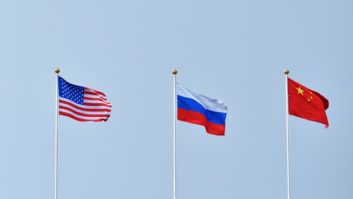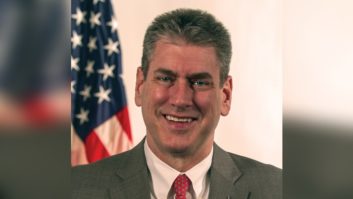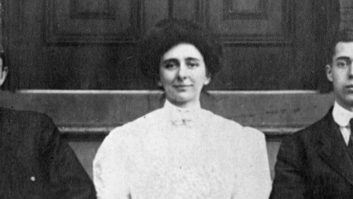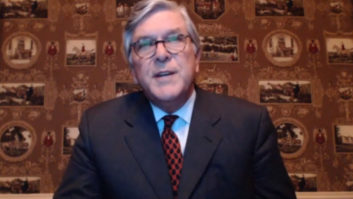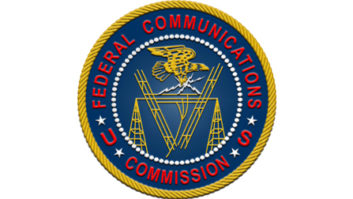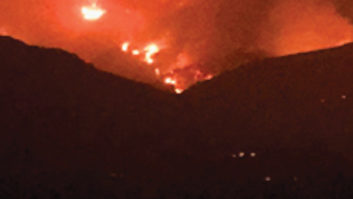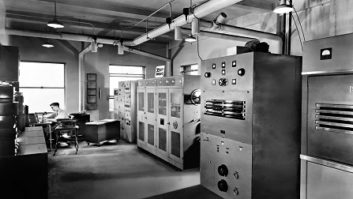The Federal Communications Commission was created on June 19, 1934, and thus marks its 75th anniversary this month. A recent article in Radio World discussed whether the FCC is still relevant. Here, we look back to its roots.
In the beginning, there was a ponderous cacophony and great confusion.

Rear Admiral W.H.G. Bullard, first chairman of the Federal Radio Commission. ‘There are no czars, as some newspapers like to suggest; we are all equals — the commission and the public,’ he said. (Photo courtesy FCC) Radio, basically in the form of broadband brute force spark transmissions, had been around since the turn of the 20th century. Some businesses made use of radio for dispatching ships and reporting meteorological conditions, others engaged in the transmission of personal and commercial messages for profit; but the simple truth was that anyone could build and operate a wireless station.
The U.S. Navy was one of the early adopters of radio communications; it frequently endured perfectly legal interference from amateur pranksters.
Stations could operate with as much power as they wished and for as long as they wanted. Call signs, if they were used, were self-assigned. In some cases, the identical call signs were used by multiple parties in various parts of the country.
Order out of chaos
By the early 1910s, radio looked as if it were here to stay, and the United States and other governments had begun to step in to police an increasingly disorganized, sometimes dangerous situation.
A first stab at regulation in the United States came with the Wireless Ship Act of 1910, in which control of the airwaves was assigned to the secretary of the Department of Commerce. (“… the Secretary of Commerce and Labor shall make such regulations as may be necessary to secure the proper execution of this Act by collectors of customs and other officers of the Government.”). It was limited in scope and essentially just mandated the carriage of radio gear for larger passenger ships.
Baby steps
Two years later saw the passage of the Radio Act of 1912. This legislation was much broader in scope, and though it failed to bridle the “wild west” nature of radio operations, it can be viewed as the foundation of the modern Federal Communications Commission.
The act had some of its roots in the Berlin Convention, an international radio accord reached in 1906. The 1912 legislation for the first time defined allowable wavelengths and purity of transmitter emissions, forbade the use of “unnecessary” power, established “SOS” as a standard distress call, proscribed the divulging of contents of transmitted messages, established the use of government issued call letters, required the licensing of stations and operators and established penalties for violations of the law.
It also covered distress operations and protection of government communications from interference.
While the act essentially confined radio transmissions to a portion of the spectrum now defined as the AM broadcast band, it did not address broadcast operations. Further, due to its legal language, it was, by and large, unenforceable.
Following the outbreak of war in Europe in 1914, and especially after the United States entered the conflict, little was done to correct flaws in the 1912 legislation.
One effect of the “Great War” was a ban by the federal government of all commercial and amateur radio activities beginning on April 7, 1917. Most stations were shut down and dismantled or pressed into government service. It became illegal for a private citizen to even possess an operational transmitter or receiver.
This monopolizing of the U.S. airwaves continued until 1919 and the return of U.S. soldiers from the European front.
Broadcasting takes off
The importance of radio in wartime operations did not go unrecognized.
It was not long after the end of hostilities that the idea of “broadcasting” as we know it became fairly widespread. Certainly there had been experimentation by a number of individuals before the war, but this was viewed as little more than a hobby by most.
One returning amateur, Frank Conrad, began to ramp up his experiments in transmitting to a general audience. This led to interest by his employer, Westinghouse, in creating a full-fledged radio station, KDKA, in 1921.
The nation — and the world — were ready for radio to enter homes in the early 1920s, and the chaotic situation that existed earlier now played out again. Stations sparred for dominance of a certain frequency. Frequency control was minimal; most transmitters were little more than modulated power oscillators, where even the changing capacitance of an antenna blowing in the wind would shift frequency. Hours of operation and power limits were subject to the whims of station owners (many of these were amateurs who were broadcasting “just for fun”).
In the year following the meteoric rise of civilian broadcasting, Herbert Hoover called the first of several special national conferences about radio. He was secretary of the Department of Commerce and was trying to deal with the somewhat suicidal success of this new entertainment medium.
Little good resulted from these meetings, aside from the addition of a second wavelength (400 meters or 750 kHz) to the existing single channel set aside for broadcasting (360 meters, or 833 kHz). Power was capped at 1 kW and the use of radio for advertising was frowned upon.
Hoover however was outspoken against the prospect of using radio to advertise:
“I believe that the quickest way to kill broadcasting would be to use it for direct advertising,” Hoover declared in 1924 at the third of the conferences, according to Robert L. Hilliard in his book “The Federal Communications Commission — A Primer.”
Despite a succession of four conferences aimed at untangling the airwaves mess in the early and mid-1920s, stations kept proliferating and interfering with each other.
Increasing the number of channels and encouragement of time-sharing did little to ease the whistles and beats as transmitters vied for supremacy of the ether. Time-sharing also meant that each station owner could use his or her facility for only a portion of the day, in some cases no more than a couple of hours.
Hoover, to his credit, tried valiantly to sort things out. But the 1912 legislation did not recognize the concept of broadcasting; and courts were full of cases that more or less successfully sidestepped any teeth in the law.
Dill-White
The sense of the times is apparent in a comment by Nevada Senator Key Pittman in the Congressional Record:
“I do not think sir, that in the 14 years I have been here there has ever been a question before the Senate that in the very nature of the thing Senators can know so little about as this subject.”
Before the Fifth Estate could be done in by its own meteoric rise, President Calvin Coolidge in 1926 stepped in and asked Congress to enact legislation to deal with the situation.
This led to the passage of the Dill-White Radio Act of 1927, which among other things created a special five-member commission to deal with growing pains of this radio infant. The unit was known as the Federal Radio Commission; it was the direct precursor of today’s FCC.
One of the provisions of the legislation was the division of the country into five “radio districts,” with a commissioner appointed to represent each. The 1927 act also provided sufficient regulatory “tooth” to fight abuses perpetrated by the spate of broadcasters hitting the airwaves.
The first chairman was Rear Admiral W.H.G. Bullard, shown at the top of this story, who was in charge of stations in the “second zone,” which encompassed Pennsylvania, Virginia, West Virginia, Ohio, Michigan and Kentucky.
He assumed office with a simple “open door” philosophy: “The only motto we have is the doormat welcome, and there are no czars, as some newspapers like to suggest; we are all equals — the commission and the public — striving to solve many different problems and propitiate the ire of perhaps some disgruntled ones,” he wrote in a report to Congress. Bullard died in November of 1927.
One of the first actions of the FRC was to silence some 150 of the nation’s more than 700 stations. Additional broadcasting channels were opened up and non-broadcast traffic was migrated outside the 550 to 1500 kHz band.
Still that was not enough.
One of the new commissioners, Henry A. Bellows, in an address to the League of Women Voters remarked on the terrible congestion that broadcasters were enduring.
“A broadcasting station is in many ways akin to a newspaper, but with this fundamental difference: There is no arbitrary limit to the number of different newspapers which may be published, whereas there is a definite limit, and a very low one, to the number of broadcasting stations which can operate simultaneously within the entire length and breath of our country.
“This limit has not only been reached; it has been far overpassed; the demand from every section of the country is to cut down the number of broadcasting stations in the interests of the listening public.”
Another FRC action was the establishment of metrics necessary for a broadcaster to hold a license. Among those were requirements that a station must serve the public interest, convenience and necessity, which carry forth to this day.
It should only take a year
The 1927 Radio Act empowered the FRC only for one year; however, the commission’s tasks were so daunting that Congress annually renewed the FRC’s licensing authority on a continuing basis. The problems it faced in regulation of the country’s growing communications systems showed no signs of going away, and a fresh Band-Aid each year was not really a solution.
It was in 1934, during Franklin Roosevelt’s first term as president, that a more permanent organization was created, the Federal Communications Commission.
The “New Deal” politics of the Roosevelt administration were not the driving force in this shift from a temporary radio regulatory body to a permanent commission.
In addition to the radio boom, the decade of the 1920s also saw the coming of television and other forms of telecommunication not covered by the 1927 Radio Act.
Further, the regulation of the country’s telegraph and telephone services could be described as a crazy quilt at best. The Interstate Commerce Commission claimed jurisdiction over a portion of these systems, as did the Department of State and the U.S. Post Office. Communications within the United States were burgeoning; it was time for a new consolidated regulatory body and a reworking of existing statutes.
The present-day Federal Communications Commission, created by the Communications Act of 1934, opened its doors for business on July 11 of that year. Seven commissioners were selected to lead the organization, with Mississippi Democrat Eugene O. Sykes, shown, named chairman.

Eugene O. Sykes, a Democrat, was the first Federal Communications chairman, assuming office on July 11, 1934. He remained with the FCC until 1939. (Photo courtesy FCC) This number was later reduced to the present-day five. Previous regulatory efforts were placed squarely in the hands of this new organization and the FRC ceased to exist.
Since its inception, the FCC has added aircraft, cable, satellite, business and citizen’s radio and other wired and wireless communications services to the FRC’s authority over marine, military, amateur radio and commercial broadcasting.
During the next several decades, the new organization had a full plate. Among its memorable decisions are the creation of superpower broadcasting, with an experimental 500,000 watt license issued to Cincinnati’s WLW; two extensions of the AM broadcast band; a reshuffling in 1941 of virtually all AM broadcasting frequencies; establishment of the 6 MHz television channels; creation of spectrum space for both FM and television broadcasting; the setting of standards for TV transmissions; commercialization of both television and FM broadcasting; the shift of the FM band from its original 42–50 MHz slot to the present 88–108 MHz spectrum; a complete reworking of television broadcasting allocations between 1948 and 1952; creation of additional television channels; later reductions in the number of TV channels; approval of the non-backwardly compatible CBS 405-line color standard in 1950; approval of the compatible “NTSC” color television broadcasting system in 1953; and approval of the present-day FM stereo system in 1961.
James O’Neal is technology editor for TV Technology and a frequent Radio World contributor. He thanks John Reiser for his assistance in reviewing this material.
Further recommended reading: “A History of Broadcasting in the United States: Volume 1, A Tower of Babel. To 1933,” by Erik Barnouw, published by Oxford University Press in 1966; “Stay Tuned: A History of American Broadcasting,” by Chris Sterling and John Michael Kittross, published by Lawrence Erlbaum Assc. in 2002 (3rd edition) and “The Radio Act of 1927 as a Product of Progressivism — Vol. 2, Number 2” by Mark Goodman, available online at http://tinyurl.com/fccrw.





